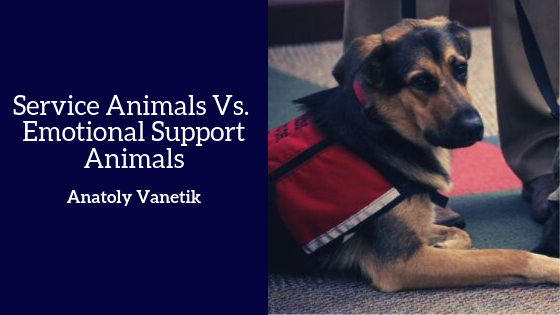It is not uncommon for people to confuse service animals with emotional support animals. Despite the presence of some overlapping similarities, both animals serve vastly different roles. In a nutshell, service animals are trained to assist a person with a disability to carry out a specific task or group of tasks. For example, while a service dog can provide emotional support to its owners, its primary function is to provide specific assistance with various tasks. An emotional support animal, on the other hand, is an animal that provides therapeutic support to a person that has been officially diagnosed with a disorder or disability. People with dementia, severe phobias, and other mental or emotional disorders can greatly benefit from emotional support animals.
5 Differences Between Service Animals vs. Emotional Support Animals
Day to Day Tasks – Service animals and emotional support animals carry out vastly different day to days tasks. A service animal may spend their day helping a blind person walk or fetching objects for an amputee. An emotional support animal spends its day solely acting as an emotional companion.
Secondary vs. Primary Emotional Support – Service animals and emotional support animals both provide companionship to their owners that is soothing. The difference, however, is that service animals provide emotional support and companionship as a secondary function. Emotional support animals provide companionship as their primary function.
Different Training Regimens – Service animals typically require rigorous and long-term training by animal experts. Some of the service animals training regimens take years to properly complete. Emotional support animals, on the other hand, require little to no training at all.
Different Breeds – Service animals and emotional support animals are typically very different animal breeds. For example, emotional support dogs are typically German Shepherds, Labrador Retrievers, Beagles, Yorkshire Terriers, and Poodles. Service dogs, on the other hand, are typically German Shepherds or Labrador Retrievers almost exclusively.
Different Medical Conditions – The medical conditions that require the assistance of a service animal or emotional support animals are typically very different. People that require a service dog may suffer from blindness, paralysis, or are physically disabled in some way. Emotional support animal owners are usually people that suffer from dementia, Alzheimer’s disease, severe depression, severe obsessive-compulsive disorder (OCD), or other mental health problems.
About The Author
Anatoly Vanetik is a Businessman and Oil and Gas Expert residing in Orange County, California. He brings over 30 years of professional experience working as an entrepreneur, and remains active as the President and Chairman for his company, Vanetik & Associates. Anatoly Vanetik is also passionate about art history and animal welfare, and has been an active supporter of animal organizations around California. He maintains an active monthly blog on animal welfare, providing helpful tips on giving back, as well as highlighting great animal organizations.
